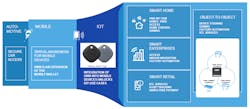NXP's UWB ICs Power Samsung’s SmartTag+ Devices
“Now, where did I put my keys?” We’ve all experienced that moment, and it happens more and more often as our days spill over with things to do and places to go. Who has enough bandwidth to keep track of everything when life is pulling us in so many directions? Fortunately, we live in an increasingly smart and connected world in which our belongings, when appropriately outfitted, can help us navigate our complex (and distracted) lives.
In that vein, NXP Semiconductors’ Trimension Ultra-Wideband (UWB) platform has been tweaked to offer fine ranging for new tagging use cases. The company has melded UWB and Bluetooth Low Energy technologies to deliver spatial awareness to the new Samsung Galaxy SmartTag+, providing an enhanced experience to the Samsung SmartThings Find service.
SmartThings Find is a service within the SmartThings application, available on select Galaxy devices, including the Galaxy S21+ and S21 Ultra smartphones. It features powerful detection capabilities that help users find their belongings, whether near or far. It can accurately locate Samsung Galaxy devices and any personal items—such as a backpack, wallet, or keys with a Galaxy SmartTag attached—through an intuitive tracking interface. With Galaxy SmartTag+ utilizing Trimension UWB and Bluetooth Low Energy, users can take advantage of augmented reality technology to visually guide them towards their missing item using their smartphone's camera. The Galaxy smartphone receives data about how far away the SmartTag+ device is, and in which direction.
The technical attributes of UWB make it ideal for these sorts of applications. It’s accurate within ±10 cm with respect to distance and angle of arrival. It’s robust, being strong in multipath environments, with lots of reflections and perhaps a tag inside a user’s pocket. Its range is up to 100 meters under line-of-sight (LoS) conditions. It also offers the advantage of extremely low latency; measurements happen in <10 ns.
A critical aspect of UWB that suits it for SmartTag+ is its secure nature. Time-of-flight (ToF) measurements are cryptographically protected, which is why one of the catalyzing use cases for UWB has been secure vehicle access. That cryptographic security prevents any bad actors from “spoofing” or tampering with the signal with distance-reduction attacks, making it appear to the vehicle’s security system that the smart key is closer to the vehicle than it is.
Two NXP devices contribute to the Samsung use case:
- NXP’s UWB IC, Trimension SR040 is optimized to enable new IoT use cases, such as smart locks and real-time location system (RTLS) tags. The IC delivers 'relative position' with a very high level of accuracy.
- NXP’s QN9090 Bluetooth LE microcontrollers support UWB use cases by providing a wireless interface for sideband communication, configuration, and activation.
NXP looks at UWB as an ecosystem and believes its products are well-positioned to drive that ecosystem (Figure 1). The basis for the ecosystem is the automotive use case and secure vehicle access. That leads into mobile use cases, where the technology lends spatial awareness to mobile devices and serves as an extension of the “mobile wallet.” The next evolution is into IoT, which is exemplified by the Samsung SmartTag+ use case. After that, smart home, smart enterprises, and smart retail come into play. Finally, object-to-object use cases will emerge, where it’s not a smartphone involved but perhaps virtual-reality glasses or a gaming console.
About the Author
David Maliniak
Executive Editor, Microwaves & RF
I am Executive Editor of Microwaves & RF, an all-digital publication that broadly covers all aspects of wireless communications. More particularly, we're keeping a close eye on technologies in the consumer-oriented 5G, 6G, IoT, M2M, and V2X markets, in which much of the wireless market's growth will occur in this decade and beyond. I work with a great team of editors to provide engineers, developers, and technical managers with interesting and useful articles and videos on a regular basis. Check out our free newsletters to see the latest content.
You can send press releases for new products for possible coverage on the website. I am also interested in receiving contributed articles for publishing on our website. Use our contributor's packet, in which you'll find an article template and lots more useful information on how to properly prepare content for us, and send to me along with a signed release form.
About me:
In his long career in the B2B electronics-industry media, David Maliniak has held editorial roles as both generalist and specialist. As Components Editor and, later, as Editor in Chief of EE Product News, David gained breadth of experience in covering the industry at large. In serving as EDA/Test and Measurement Technology Editor at Electronic Design, he developed deep insight into those complex areas of technology. Most recently, David worked in technical marketing communications at Teledyne LeCroy, leaving to rejoin the EOEM B2B publishing world in January 2020. David earned a B.A. in journalism at New York University.


